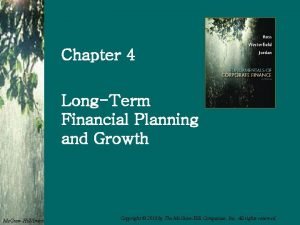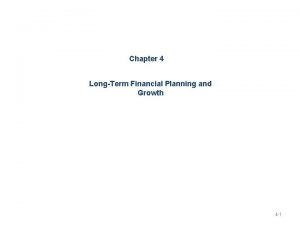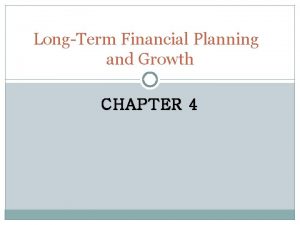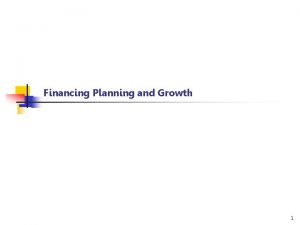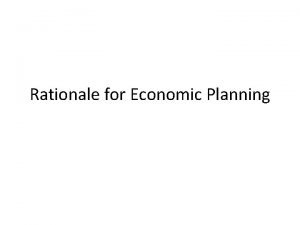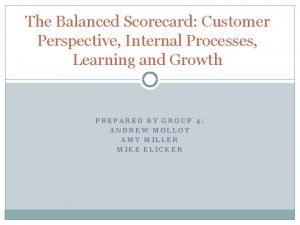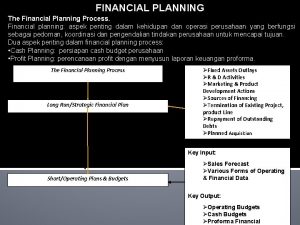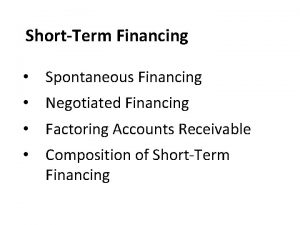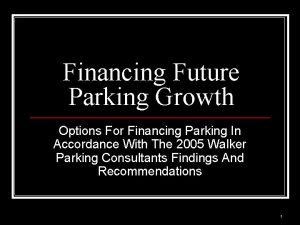Financing Planning and Growth 1 Rationale for Financial











- Slides: 11

Financing Planning and Growth 1

Rationale for Financial Planning q Plan for growth and change q Deal with complexity and uncertainty q Determine reasonable financial goals q Implement financial policies q Remained focused and in control q Plan and monitor cash flows q Plan investments and financing q Meet loan covenants q Communicate with lenders and investors 2

Types of Financial Plans Short-term planning. Focuses on the financial aspects of a company’s operations: q q Sufficient cash to meet its obligations Needed financing for projected growth in its working capital and long-term assets Compliance with its lending conditions Adhering to its financial policies relating to dividend payment, maturity matching or financial leverage q Achieving its financial goals and objectives relating to profitability Long-term planning. Focuses on growth, the assets needed to support this growth, and whether the company can obtain the needed financing without: q Exceeding its optimal borrowing level q Issuing expensive new equity that may create control problems for existing owners If growth cannot be financed safely, a company may have to reduce its growth rate – its bankers will likely insist. 3

Short-term Financial Planning A short-term financial plans consists of the following for the next year: q Budgeted income statement q Cash flow budget q Budgeted balance sheet q Key financial ratios 4

Making the Most of Financial Planning 1. Spreadsheets q Automation q Input page with all budget variables 2. Sensitivity Analysis q Varies one input at a time q Used if budgeting outcomes are particularly sensitive to one variable 3. Scenario Analysis – Best Case, Worst Case, and Most Likely q Each scenario varies more than one variable q Companies must be ready for all possible scenarios 4. Simulation q All budget inputs are varied at once over a defined range and frequency resulting in a probability distribution of expected outcomes 5

Long-term Financial Planning q Percentage of sales method is used to prepare long-term financial plans as they can be quickly developed based on a sales forecast q Method is based on two assumptions: q Company’s operating expenses, working capital items and long-term assets grow at the same rate as sales and thus remain at the same percentage of sales q For long-term liabilities and equity, their total value will be equal to assets minus current liabilities and the proportion of each is dependent on the company’s target capital structure q For operating expenses, these assumptions are reasonable q For working capital and long-term assets it assumes a constant capital intensity ratio q Percentage of sales is imprecise due to economies of scale and idle production capacity q Level of accuracy is likely sufficient given the high level of uncertainty in the longer term 6

Sustainable Growth q Sustainable growth rate (SGR) is the growth rate of sales that can be supported with no new issuances of common equity and constant financial fundamentals (ROE, retention ratio, and debt/equity) q Actual sales growth can be higher than sustainable growth if new common equity is sold or the debt ratio is increased q May choose to grow at a slower rate than the SGR but cash will accumulate in the business q Most companies try to grow using retained earnings as their only source of equity financing because: q Control issues for existing common shareholders q Issuance costs for new common equity are high especially for start-ups and small businesses q New common equity may be unavailable for small businesses q Short-term dilution of EPS (takes time to use new common equity effectively) q Managers are very concerned about issuing common shares when they are undervalued q Companies and their creditors monitor the SGR carefully to maximize growth but also to limit the risk of bankruptcy from growing too fast 7

SGR Formula Profitability Asset Turnover Financial Leverage 8

Managing the SGR What can be done to raise the SGR? q 1. Increase profit margins q Raise prices if profitable as this will reduce growth in units and needed capital expenditures 2. Increase asset turnover q q Outsource non-essential activities that required large capital investments Use “profitability pruning” to sell business units with low profitability that required large capital expenditures 3. Lower the dividend payout ratio What can be done if growth falls below the SGR? 1. Expand the number of products and services offered 2. Diversify into related fields 3. Raise the payout ratio or buy back shares q When expanding, be sure projects have positive net present values q Unrelated diversification and acquisitions are usually unsuccessful, so give serious thought to raising the dividend payout ratio – paying dividends is not a sign of failure, but a sign that management is trying to reduce its agency costs q Don’t hoard cash or make bad investments as the company will be a target for corporate raiders due to low investment returns and a depressed share price 4. Use more financial leverage q q More financial leverage can be used, but be wary of potential bankruptcy Reducing the dividend payout creates considerable market pessimism resulting in a lower share price Bankers use a large difference between the sustainable and actual growth rates as a “red flag” that high borrowing is not sustainable 9

Analyzing Sustainable Growth at Wicker Company 2011 2012 2013 2014 2015 Retention ratio 1. 00 0. 90 0. 85 0. 74 0. 65 Net profit margin (%) 7. 90 8. 10 8. 20 8. 40 Asset turnover 1. 34 1. 22 1. 17 1. 14 1. 07 Assets/equity 2. 49 2. 15 1. 81 1. 61 1. 31 35. 79 23. 64 17. 07 12. 53 8. 29 5. 67 8. 95 10. 10 9. 45 8. 73 SGR (%) Actual growth rate (%) 10

Analyzing Sustainable Growth at Tesla Fashion 2011 2012 2013 2014 2015 Retention ratio 1. 00 Profit margin (%) 0. 45 0. 52 2. 85 3. 72 3. 81 Asset turnover 2. 24 2. 41 2. 48 2. 51 2. 53 Assets/equity 1. 85 2. 01 2. 19 2. 39 SGR (%) 1. 90 2. 37 16. 56 25. 70 29. 93 Actual growth rate (%) 8. 90 10. 30 18. 90 29. 85 11
 Long term financial planning and growth chapter 4
Long term financial planning and growth chapter 4 Long term financial planning and growth
Long term financial planning and growth Long term financial planning and growth
Long term financial planning and growth Sgr formula
Sgr formula What are the rationale of economic planning
What are the rationale of economic planning Relative growth rate equation
Relative growth rate equation Monocot vs eudicot
Monocot vs eudicot Primary growth and secondary growth in plants
Primary growth and secondary growth in plants Chapter 35 plant structure growth and development
Chapter 35 plant structure growth and development Balanced scorecard customer perspective
Balanced scorecard customer perspective Step growth polymerization vs chain growth
Step growth polymerization vs chain growth Geometric exponential growth
Geometric exponential growth
